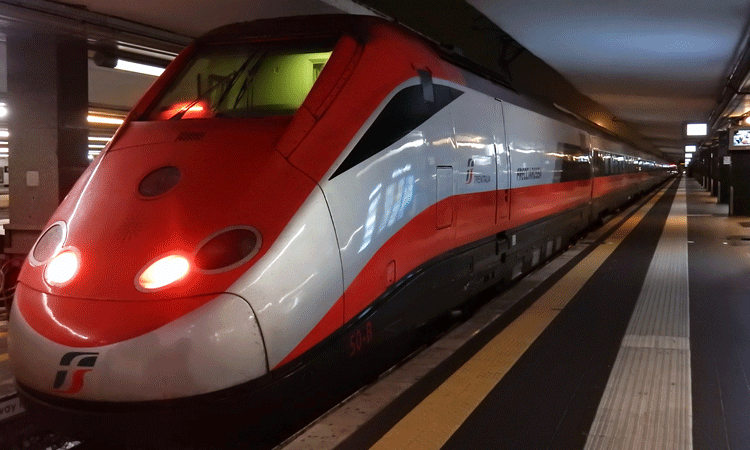Naples–Bari and Palermo–Catania–Messina high-speed/high-capacity lines
Posted: 6 August 2015 | | No comments yet
The Naples–Bari and Palermo–Catania–Messina high-speed/high-capacity (HS/HC) itineraries are among the main works included in the so-called ‘Unlock-Italy’ Law no. 164 of 11 November 2014. The Italian government aims to give the country a strong sign of recovery in both the economy and employment – commencing in the South – through these works.


The Naples–Bari and Palermo–Catania–Messina high-speed/high-capacity (HS/HC) itineraries are among the main works included in the so-called ‘Unlock-Italy’ Law no. 164 of 11 November 2014. The Italian government aims to give the country a strong sign of recovery in both the economy and employment – commencing in the South – through these works.
These are important works to improve the railway system and develop both the territory and social cohesion that are strategic to Italy and Gruppo FS Italiane and it is no coincidence that they have been included in Corridor 5 ‘Scandinavia–Mediterranean’ of the Trans-European Railway Network (TEN-T).
Constructing the Naples–Bari HS/HC lines along the Naples–Bari–Lecce–Taranto and Palermo–Catania–Messina main line is a clear sign of renewed attention being paid to Southern Italy by national institutions entailing effective creation of infrastructures that FS Italiane has always supported. This is an important goal that can be achieved through the process of acceleration and simplification advocated by the government to construct infrastructural works considered strategic, non-deferrable and urgent throughout Italy.
As part of this context, as FS Italiane CEO, I was appointed as pro tempore Commissioner for execution of these two works by the government with the task of speeding-up procedures and opening relative worksites by October. In fact, as Commissioner, I have the institutional task and role of speeding up authorisation procedures regarding the design stages through provisions that take the form of orders. At the time of providing this article, 10 such provisions have already been issued. This is useful not so much with regard to speeding up local authorisations, but in relation to approving projects, which no longer require approval from mission units and the Inter-Ministerial Committee for Economic Planning. The final objective is to cut costs and the time required to execute works, in which the roles of Rete Ferroviaria Italiana as Sub-Contractor and Customer and Italferr as Technical Subject are important.
Naples–Bari HS/HC line
Commencing with the longest and most complex itinerary – Naples–Bari – this programme entails doubling and adding alternative lines to the current line to increase capacity and speed. This includes an alternative track on the Cancello–Naples line to join the HS/HC line, doubling and improving speed on the Cancello–Frasso Telesino–Benevento section, adding a second track on the Apice–Orsara line, doubling the Orsara–Bovino section, doubling the Cervaro–Bovino section, Foggia branch line and Bari Hub – alternative Bari Sud track (Bari Central Station–Bari Torre a Mare).
Implementation of this simplification process means that worksites are expected to commence by October 2015 rather than May 2018, thereby bringing forward the schedule laid down in the Institutional Development Agreement signed in 2012 by just under three years. The target is to complete works on the first sections by spring 2021 rather than summer 2023 and thereby activate these much earlier than would have occurred under the standard procedure for works. For example, the Bovino–Cervaro section could be activated in spring rather than autumn 2017 and the Bari Hub in autumn 2020 rather than in 2022.
Let’s come to the benefits deriving from the implementation of the Naples–Bari itinerary. This work will above all ensure that railway infrastructure in south-east Italy – especially in Puglia and inland provinces in Campania – can be linked to the main lines heading to north Italy and Europe, thereby supporting social and economic development in southern Italy.
Tripolarising Rome–Naples–Bari will lead to the creation of an extremely important line between central and southern Italy with high-quality services. The transversal Naples–Bari link plays an essential role in development of southern Italy as it connects two areas that alone are responsible for over 40% of market production in southern Italy.
The benefits to the overall population are numerous. These include above all a considerable decrease in journey times – you can travel between Rome and Bari in just 3 hours with respect to 4 hours now and between Naples and Bari in just 2 hours with respect to 3 hours 40 minutes now – and an improvement to rail services offered, not to mention integrated network services and intermodality, environmental sustainability and bringing large cities closer to each other. There is also a considerable social impact to employment from creation of this itinerary: initial works alone are estimated to involve around 2,200 skilled workers per month on average, 2,000 of whom for the works and 200 in related industries. This is an important driving force for the economy in the areas involved and, generally speaking, for the country.
These objectives can be achieved both through the infrastructural works described until now and through the technological upgrades required to reduce overall journey times, thereby speeding up the Naples–Bari and Bari–Lecce lines (forecast for completion by the end of 2017) and restoring the Naples–Bari freight line at Foggia with a link between the Foggia–Bari and Foggia–Naples lines to reduce journey times for trains along the Bari–Caserta line (forecast for completion by the end of summer 2015). These projects join other works currently being planned or executed, which are forecast for completion by the end of 2017, i.e. infrastructural and technological improvements to the Caserta–Foggia line, especially the Cervaro–Bovino section, amending the General Town Planning Scheme and computerising the central equipment in Lecce and upgrading infrastructure on the Bologna–Brindisi–Lecce line as part of more extensive upgrading for the Adriatic line.
The overall estimated cost for works on the Napoli–Bari line is around €6.2 billion – over €3 billion of which are already available through EU and Italian funds pursuant to the 2012-2016 Planning Agreement and €1.5 billion of which may come from the proposed 2014-2020 PON.
Great attention will also be paid to promoting meetings with territorial authorities to share drafts and discuss matters with relative ministries and thereby identify any financial resources available for sections that still lack the necessary funds.
Palermo–Catania–Messina HS/HC line
Worksites for the other important HS/HC itinerary included in the so-called ‘Unlock Italy’ Law – is the Palermo–Catania–Messina line – expected to commence by the end of October 2015. In this case too, as with regard to the Naples–Bari line, the procedure to speed up and simplify matters implemented by the government through this law and appointment of a Commissioner ensure that approval of the project will take place almost two years before the timescale laid down in the Institutional Development Agreement.
This infrastructure – entailing estimated overall costs of over €8.6 billion – will ensure interconnection of the most-populated towns and cities with inland and coastal areas in Sicily and relative services, thereby guaranteeing mobility for passengers and freight and linking the Ionic and Tyrrhenian main lines, saving time and assuring benefits in terms of general safety.
Various works are planned to make the line faster. Preliminary plans are currently being drawn up for most of these entailing technical roundtables with the relative institutional entities both to authorise relative projects and to identify the financial resources required. More specifically, plans are being made to double the Giampilieri–Fiumefreddo line, upgrade the Catania hub, double the Bicocca–Motta–Catenanuova line, double the Catenanuova–Raddusa line and double the Raddusa–Enna–Fiumetorto line.
Infrastructural and technological works have already commenced in Sicily entailing investment of around €2.5 billion to double the Catania Ognina–Catania Central line (Catania Hub), double the Fiumetorto–Castelbuono line and technologically upgrade the Palermo Hub, as well as to implement technological improvements to speed up the Messina–Siracusa, Palermo–Messina and Palermo–Catania main lines.
The new HS/HC Palermo–Catania–Messina line is also expected to provide numerous benefits, above all improvement to infrastructural capacity, commercial offers and quality in rail services. The reduced travelling times involved are also considerable: when fully-operational, passengers can reach Catania from Palermo in just 1 hour 44 minutes and from Messina in just 46 minutes. Constructing this line will also relieve rail traffic congestion and reduce CO2 emissions and hydraulic risk to railway infrastructures. Furthermore, passengers can be ensured better access to the cities of Enna and Caltanissetta and an integrated network between the main infrastructures on the island (airports, ports, interports, motorways and complementary railway lines) and the logistics platform for freight transport, as well as optimisation of costs for passenger and freight transport, thereby guaranteeing positive effects from industrial, tourist, social and cultural viewpoints. All the above represent a great opportunity to relaunch the local economy, also in terms of employment: the first stage of works alone is estimated to require use of 1,900 skilled workers a month.
Safety and technology will play a leading role in development of these two projects. On-going attention to technological innovation entailing investment of €5 billion over the last few years ensures that Italian railways are currently the safest in Europe1. A railway network exceeding 16,700km used by around 9,000 trains every day is currently equipped with safety systems in line with the traffic involved and top speeds that trains can reach. Centralised technological systems have been developed to manage and control circulation, thereby allowing operators to supervise the location of trains on the network, in stations and at stops in real time.
With a view to providing accurate and transparent information to the public and institutions regarding both the Naples–Bari and the Palermo–Catania–Messina projects, an ad hoc section online2 and two specific websites3 have been developed to provide updated information on the activities, provisions by the Commissioner and progress in works.
Reference
- Source: UIC
- it (fsitaliane.it/fsi/Impegno/Per-lo-Sviluppo)
- it and palermocataniamessina.it
Biography
Michele Mario Elia graduated in Electrical Engineering from Bari University and later qualified as an Electrical Engineer. He began his career with Ferrovie dello Stato in 1975 and has been CEO since 30 May 2014. Other roles include President of Grandi Stazioni, the Gruppo FS Italiane Company responsible for managing, renovating and improving the main stations throughout Italy (as of 2014), Commissioner for works relating to the Napoli–Bari and Palermo–Catania–Messina lines appointed by the Italian Government (as of 2014); and Vice President of UIC (International Union of Railways) and President of UIC Europe (as of 2014).







